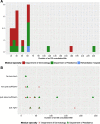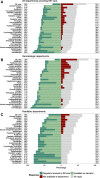Mapping health care of rare diseases: the example of epidermolysis bullosa in Germany
- PMID: 30409176
- PMCID: PMC6225719
- DOI: 10.1186/s13023-018-0944-x
Mapping health care of rare diseases: the example of epidermolysis bullosa in Germany
Abstract
Background: Rare diseases affect approximately 30 million people in the European Union and present a major health issue. Over 1000 rare skin diseases are known, many of which are of genetic origin and manifest in childhood. One of these diseases is epidermolysis bullosa (EB), a genodermatosis presenting with skin fragility and blistering. With an estimate of up to 2000 affected individuals in Germany, many of these children, but only two specialist centres, the question arose where and how health care for this rare disease is provided. This question was addressed by an online survey of all paediatric and dermatological departments in Germany.
Results: The response rate was 40.5% (203/501), and 39 departments confirmed treating EB (7.8% of the units addressed). Health care for individuals with EB was provided both by dermatological and paediatric departments (19.8 and 4.2% respectively). The geographic distribution of EB health care was uneven. The two EB centres in Hanover and Freiburg treated 70 and 113 patients, two other departments saw 11 to 20 patients, while the majority saw less than 10 patients annually. There existed large variations between 1. the consultation setting, time frame and frequency, 2. the recommended examinations and check-ups and 3. the diagnostics used to establish the diagnosis. Over 50% of participating physicians were dissatisfied with health care outside of hospitals and more than 20% with their patients' supply with bandages or medications.
Conclusions: The survey results show that health care for individuals with EB in Germany is provided multidisciplinarily. Approaches to diagnostics and follow-up recommendations are heterogeneous and national guidelines are lacking. Functioning and innovative political structures are needed to improve networking and strengthening specialised centres to meet the special needs of individuals with EB and other rare diseases.
Keywords: Epidermolysis bullosa; Genodermatoses; Health care; Paediatric dermatology; Rare disease; Survey.
Conflict of interest statement
Ethics approval and consent to participate
This study was approved by the ethics committee of the University of Freiburg (vote Nr. 461/17).
Consent for publication
Not applicable.
Competing interests
The authors declare that they have no competing interests.
Publisher’s Note
Springer Nature remains neutral with regard to jurisdictional claims in published maps and institutional affiliations.
Figures









References
-
- Commission on the European communities . Communication from the commission to the European parliament, the council, the European economic and social committee and the committee of the regions on Rare Diseases: Europe’s challenges {SEC (2008)2713} {SEC (2008)2712} 2008.
-
- European Commission . Implementation report on the commission communication on rare diseases: Europe’s challenges [COM (2008) 679 final] and council recommendation of 8 June 2009 on an action in the field of rare diseases (2009/C 151/02) 2014.
-
- European Union Council recommendation of 8 June 2009 on an action in the field of rare diseases (2009/C 151/02) Off J Eur Union. 2009;C 151:7–10.
MeSH terms
LinkOut - more resources
Full Text Sources
Medical

